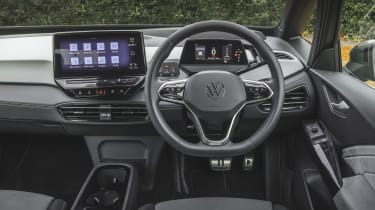Volkswagen ID.3 review
The recently updated Volkswagen ID.3 hatchback is vastly improved inside, but the fiddly infotainment system remains
Pros
- Good to drive
- Decent range and power
- Stylish but not flashy looks
Cons
- Weak regenerative braking
- Glitchy infotainment
- Bigger battery car only has four seats
| Battery size | Range | Wallbox charge time | Rapid charge time |
|---|---|---|---|
| 58kWh | 265 miles | 9hrs 15mins (0-100%, 7.4kW) | 32 mins (10-80%, 120kW) |
| 77kWh | 347 miles | 12hrs 15mins (0-100%, 7.4kW) | 28 mins (10-80%, 135kW) |
Volkswagen ID.3 verdict
By bringing forward the car’s mid-life facelift, the Volkswagen ID.3 retains its competitive edge in a crowded part of the market. A simple lineup of batteries and specs means choosing the right car for you is easy, while big improvements in cabin quality finally make the VW’s electric family hatchback feel worthy of its near-£40k starting price.
It’s not without its issues, however. That aforementioned facelift didn’t include changes to the slow, glitchy and troublesome infotainment system – those looking for improvements there will need to wait until mid-2024 when VW is set to introduce a new 12-inch screen with backlit climate controls. It’s possible that these upgrades would allow the ID.3 to catch – and possibly even surpass – rivals from Renault, Kia and even Tesla.
Range details, specs and alternatives
The ID.3 was the first entry in Volkswagen’s rapidly expanding lineup of bespoke electric cars (following the ageing e-up! city car) which now includes the ID.4 SUV, ID.5 coupe-SUV and ID. Buzz minibus, while the ID.7 saloon is due to arrive later this year. It’s also the model that Volkswagen hopes will come to define how we see the next generation of family cars, in the same way the Beetle and Golf did in their respective eras. It’s clear that this is a very important EV for the German automaker.
Competition includes cars of all shapes, sizes, and fuel types. On one hand you have traditional petrol and diesel-powered hatchbacks like the Ford Focus, Vauxhall Astra and Volkswagen Golf. Then there are electric models such as the budget-friendly MG4 EV, sporty Cupra Born, long-lived Nissan Leaf, and stylish Renault Megane E-Tech. There are also a smattering of other zero-emissions family cars in the same price range, including the Kia Niro EV, the new Hyundai Kona Electric and even the Tesla Model 3.
The Volkswagen ID.3 lineup was facelifted in mid-2023 – 12 months earlier than originally planned. The main reason for this was to address a variety of common criticisms, particularly regarding interior quality. With the update came a simplified model lineup, now with just two specs and two batteries to choose from. Prices are more competitive too, with the base ID.3 starting from just over £37k.
That entry-level car is now badged ‘Pro’ and comes with a 201bhp rear-mounted electric motor and a 58kWh battery good for 265 miles of range. All cars get at least 18-inch alloy wheels (the horrid plastic wheel trims of the old car have been ditched) and LED lights, plus a 10-inch touchscreen, 5.3-inch digital instrument display and keyless entry and start. Every 58kWh model also gets 120kW rapid charging.
Upgrading to ‘Pro S’ gets the same motor but adds a larger 77kWh battery for a longer 347-mile range – there is no option to match the S spec with the smaller battery at the moment. These cars up the kit count with bigger wheels, and fancier seats with electric lumbar support.
You’ll pay almost £6k more for the Pro S, but you’ll benefit from much faster 170kW charging, which means the range-topper can perform a 10-80% top-up four minutes faster (28 minutes total) than the Pro, despite its bigger battery.
Click here to see why you can trust DrivingElectric reviews, or for a more detailed look at the Volkswagen ID.3, read on for the rest of our in-depth review

